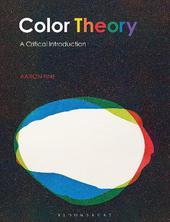
|
Color Theory: A Critical Introduction
Paperback / softback
Main Details
| Title |
Color Theory: A Critical Introduction
|
| Authors and Contributors |
By (author) Aaron Fine
|
| Physical Properties |
| Format:Paperback / softback | | Pages:376 | | Dimensions(mm): Height 246,Width 189 |
|
| Category/Genre | Theory of art
Art History
Philosophy - aesthetics |
|---|
| ISBN/Barcode |
9781350027305
|
| Classifications | Dewey:701.85 |
|---|
| Audience | | Professional & Vocational | |
|---|
| Illustrations |
162 color and bw illus
|
|
Publishing Details |
| Publisher |
Bloomsbury Publishing PLC
|
| Imprint |
Bloomsbury Visual Arts
|
| NZ Release Date |
4 November 2021 |
| Publication Country |
United Kingdom
|
Description
Giving an overview of the history of color theory from ancient and classical cultures to contemporary contexts, this book explores important critical principles and provides practical guidance on the use of color in art and design. Going beyond a simple recitation of what has historically been said about color, artist and educator Aaron Fine provides an intellectual history, critiquing prevailing Western ideas on the subject and challenging assumptions. He analyses colonialist and gendered attitudes, materialist and romanticist perspectives, spiritualist approaches to color, color in the age of reproduction, and modernist and post-modernist color strategies. Highlighted throughout are examples of the ways in which attitudes towards color have been impacted by the legacy of colonialism and are tied up with race, gender, and class. Topics covered include color models, wheels and charts, color interaction and theories of perception, with over 150 images throughout. By placing under-examined tenets of color theory such as the color wheel and color primaries within the Western industrial context that generated them, Fine helps you to connect color choices to color meanings and apply theory to practice.
Author Biography
Aaron Fine is Professor of Art, and Chair, at Truman State University, USA, where he teaches drawing, painting, and history of design - among other topics. He has 10 solo exhibitions and over 50 group exhibitions on his CV and 20 years experience teaching in art and interdisciplinary studies at the college level. He received an MFA in Painting from Claremont Graduate University, USA. He is the author of the mixed genre creative nonfiction book Dialogues on Color (2017).
ReviewsAlmost everyone sees color - but this might be the only general statement it is possible to make on the subject. When we begin to ask how color is seen and what it is seen to mean, what value colour has and to whom: then any notion of a consensus quickly falls apart. Aaron Fine's rich and wide-ranging study discusses numerous theories of color, some intersecting and overlapping, others divergent and conflicting. This book is an invaluable resource for anyone interested in how different cultures have interpreted the vibrant patterns of reflected light that almost all of us see. -- David Batchelor, artist and writer, UK Color Theory is a superb book. With impeccable scholarship it spans centuries, regions and disciplines to give the reader a panoptic account of the many guises of colour in society, art and philosophy. Fine's prose is clear and thought-provoking. Readers new to the theory of colour will have no better guide to the subject, and those already familiar will discover many new and intriguing things. -- Mazviita Chirimuuta, Senior Lecturer in Philosophy, University of Edinburgh, UK If you are curious about learning color theory, I suggest that you experiment with some watercolor. If you are serious about color theory, I suggest you read Aaron Fine's book. This is the intelligent and active approach to the subject. Placed on a spectrum between John Gage's heady and densely academic, historical color books and the excellent 'semester-minded' color texts of the like of Pentak and Zelanski, Fine's book provides toothsome material for the advanced student with opportunities for practical application and testing of theory. While many color texts have slapped a 'global color' chapter at the last of the book, Fine squares the world and its people into the beginning perspectives in chapter 1 and works out from there. This is, I hope, the beginning of a new generation of color writing that embraces a thoughtful, world perspective -- Scott Betz, Professor of Art, Winston-Salem State University, USA
|